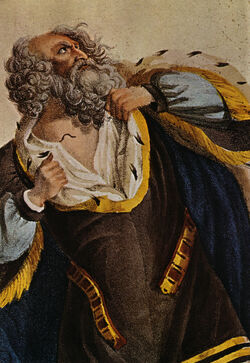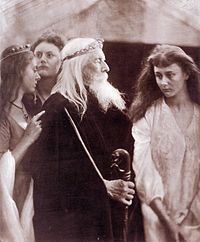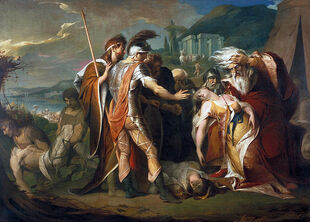
1769 depiction of King Lear by an unknown artist.
King Lear is a play by William Shakespeare that is believed to have been written between 1603 and 1606. The earliest known performance was on December 26, 1606.
The main character, Lear, is an old man who has been King of Britain for many years. He decides to hand over control of his kingdom to his three daughters, Goneril, Regan and Cordelia, dividing the lands between the three of them with the daughter who loves him the most receiving the largest part of the country. Lear mistakenly gets the impression that Cordelia does not love him at all and she receives nothing. Lear later discovers that Cordelia loves him much more than Goneril and Regan, who insult and abuse him. Not wanting to stay with either Goneril or Regan, Lear becomes homeless and gradually goes mad. With the support of her husband, the King of France, Cordelia later tries to regain the kingdom for her father but her troops are defeated and the play ends tragically with the deaths of Cordelia and her father. A sub-plot centers around Edmund, the illegitimate son of the Earl of Gloucester, and his dealings with his father and his older brother Edgar.
The main source for King Lear, as for Macbeth and all of Shakespeare's plays about historical English kings, was the 1587 edition of Raphael Holinshed's Chronicles of England, Scotland and Ireland. The story of King Leir (as the monarch's name was always spelt before Shakespeare's time) first appeared in written form in Latin in Geoffrey of Monmouth's 12th century work History of the Kings of Britain. In Geoffrey's account, Leir, founder of the English city of Leicester, was King of Britain before the Roman invasion, several centuries before the time of King Arthur. Shakespeare's play follows Geoffrey's version quite closely. In Geoffrey's account, however, Cordelia and Lear survive, Lear is restored to the throne and goes on to reign for many more years. After his death, the once neglected and mistreated Cordelia reigns as Queen of Britain, giving the story some similarities to the fairy tale "Cinderella".
The story of a father who asks his daughter how much she loves him, receives an unusual answer, mistakenly believes that his daughter does not love him at all, disowns her and discovers his great mistake much later, is also a theme in many folktales and fairy tales.
Shakespeare's King Lear was first published in book form in 1608 in an edition known as the First Quarto (Q1). A different version appeared in the First Folio (F1), the first edition of the complete works of Shakespeare published in 1623, seven years after Shakespeare's death. Q1 contains two hundred and eighty-five lines that are not in F1 and F1 contains a hundred lines that are not in Q1. Much of the dialog that appears as prose in Q1 appears as poetry in F1. Since the publication of Alexander Pope's editions of the works of Shakespeare in the 18th century, it has been standard practice for editions of King Lear to be based on a combination of F1 and Q1. Some modern Shakespeare scholars claim that both versions are equally worthy of merit. The Q1 and F1 versions of King Lear are both published separately by The New Cambridge Shakespeare and the most recent edition of the Pelican Shakespeare's King Lear contains the Q1 and F1 texts and a combination of the two.
Plot[]
Act I[]

1872 photograph by Julia Margaret Cameron which represents King Lear and his three daughters. King Lear is played by the photographer's husband. The daughter on the right is played by Alice Lidell who earlier inspired the main character in Lewis Carroll's Alice's Adventures in Wonderland and Through the Looking-Glass.
The elderly King Lear has decided that he is too old to continue reigning and that he should divide his kingdom between his three daughters, Goneril, Regan and Cordelia, according to how much each daughter loves him. Cordelia is his favorite daughter and he is certain that she loves him the most. However, whereas Goneril and Regan make extravagant claims of how much they love ther father, Cordelia simply says that she loves him as much as a daughter should love her father and no more. Lear is angered by Cordelia's response. He banishes her from his kingdom, allowing the visiting King of France to take her as his wife. The Earl of Kent is also banished for defending Cordelia, although he disguises himself and remains in Lear's service.
Lear divides his kingdom between Goneril and Regan and announces that he will alternately live with Goneril and her husband the Duke of Albany and Regan and her husband the Duke of Cornwall. He first goes to stay with Goneril, accompanied by a hundred loyal followers, including several knights and a Fool. However, Goneril soon conspires to drive her father out of her house, insulting him and insisting that his one hundred followers be reduced to fifty. Lear comes to the realisation that Cordelia was not so disrespectful of him after all. He decides to leave for the home of Regan, certain that he will be better treated there, sending Kent ahead as a messenger to inform Regan that he is coming.
Act II[]

Goneril and Regan are depicted in this 1902 painting by Edwin Austin Abbey.
Edmund, the illegitimate son of the Earl of Gloucester, is seen as a love interest by both Goneril and Regan, even though they are both already married. Edmund tries to destroy the reputation of his older brother Edgar, the Earl's legitimate son, by convincing his father that Edgar had plotted to kill him. Gloucester believes Edmund's lies and Edgar is forced to flee and live in disguise.
Following a fight with Goneril's steward Oswald, Lear's loyal follower Kent is punished by Regan by being put in stocks. Lear, having lost all his authority, is unable to persuade his daughters to release Kent.
After consulting with Goneril, Regan allows Lear to stay with her but only on the condition that he live there alone, without any of his followers. Unwilling to accept that condition, Lear decides that he does not want to live with either of his daughters.
Act III[]

King Lear and the Fool in the Storm, 19th century painting by William Dyce.
Lear has become homeless and begins to show signs of going mad. Having no refuge, he is forced to face a storm in the open air. He later says that the physical pain that he suffered as a result of living outdoors helped him to forget the emotional pain that his daughters caused him.
Cordelia's husband, the King of France, plans to invade. Gloucester supports the planned invasion and tells his son Edmund about it. Edmund betrays his father by passing the information on to Regan's husband the Duke of Cornwall. Edmund is rewarded for his treachery by being named as the new Earl of Gloucester in place of his father. He is told to bring his father to the Duke of Cornwall for punishment.
Finding shelter in a farmhouse, Lear holds a mock trial for Goneril and Regan, addressing two stools as if they were his daughters. Kent convinces Lear to follow him to Dover where he will be safe.
Gloucester is captured. He is tortured by having his beard torn from his face before being blinded by having his eyes gouged out. One of the Duke of Cornwall's servants cannot bear his master's cruelty any longer and attacks him.
Act IV[]

Cordelia cares for King Lear in this 19th century painting by Ford Madox Brown.
Cordelia returns with French troops, set to do battle with the forces of Goneril and Regan. Regan's husband the Duke of Cornwall has died and Goneril's husband the Duke of Albany has abandonned her to fight on Cordelia's side. The competition between Goneril and Regan for the love of Edmund starts to intensify.
The blinded Gloucester meets with "poor Tom", not knowing that "poor Tom" is really his son Edgar. Gloucester announces that he wants to commit suicide by throwing himself off the cliffs of Dover. Edgar agrees to lead him there but, on arrival, tricks him into thinking that he miraculously survived his fall.
Lear is reunited with Gloucester and then with Cordelia. He expresses deep regret for his mistreatment of her. Cordelia and Kent take care of Lear and his madness slowly passes.
Goneril's steward Oswald tries to murder Gloucester but is killed by Edgar. Oswald is found to be carrying a note from Goneril to Edmund, telling him to kill the Duke of Albany, so that the widowed Goneril and Edmund would be free to marry.
Act V[]

King Lear Mourns Cordelia's Death, 18th century painting by James Barry.
The Duke of Albany agrees to fight with Goneril and Regan against the invading French army but says that no harm should be done to Cordelia or Lear. Cordelia's forces are defeated. She and Lear are taken prisoner, Edmund having prepared orders for them to be put to death.
Regan announces that she will marry Edmund but Albany reveals how Edmund and Goneril conspired with each other and calls Edmund a traitor. Regan suddenly drops dead, due to Goneril having poisoned her food. Edgar reveals his true identity to Edmund and challenges him to a duel. Edmund is mortally wounded but does not die straight away.
Albany shows Goneril the letter in which she asked for him to be killed. She flees in shame and later commits suicide.
Edgar reveals his true identity to his father. Gloucester is delighted to be reunited with his son but is unable to take the emotional strain of all that he has been through and instantly dies.
The dying Edmund has a change of heart and tries to halt the executions of Lear and Cordelia. Lear is saved but it is too late for Cordelia. Lear enters, carrying Cordelia's dead body in his arms. Like Gloucester, he also is unable to take the emotional strain of everything that he has been through and he falls down dead.
Albany is left with the responsibility of restoring peace to the kingdom.
See also[]
- Sound files of public domain audiobooks from LibriVox:
- King Lear Act I
- King Lear Act II
- King Lear Act III
- King Lear Act IV
- King Lear Act V
- Children's story adaptation of King Lear from the 1807 book Tales from Shakespeare by Charles and Mary Lamb
- Video of the 1910 Italian silent film King Lear (intertitles in English)
- Video of the 1916 American silent film King Lear
